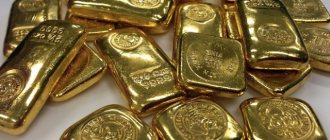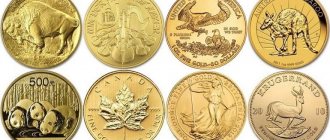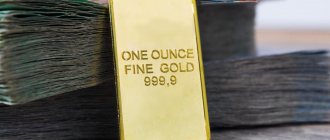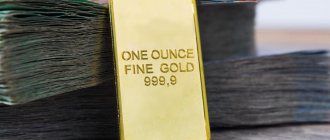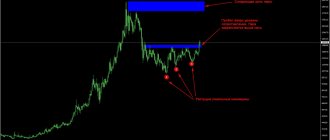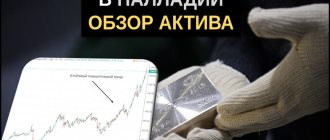Without exaggeration, gold can be called one of the most popular precious metals. It is gold that is considered to be a safe haven asset to which funds should be transferred in the event of financial crises. However, as it turned out, in 2021, competent participants in the financial market were divided into 2 groups: some believe that gold has already outlived its usefulness, since investing in a pure asset will not allow one to receive passive profit (dividends), while others are convinced that gold is the only real money who are not afraid of inflation and other troubles of modern economic reality.
What is striking is that the opinions mentioned above do not contradict each other in any way. Each of the beliefs can be considered fair. Everything depends on the specific macroeconomic situation. For example, in 2020-2021 gold is in high demand due to economic instability caused by COVID-19. The price of gold is growing steadily in the medium term, and periodically occurring local downward trends are only a natural correction of the global upward trend.
Let's not forget that gold is a limited resource, despite the fact that the demand for this metal is consistently high. This fact practically guarantees the continuation of the global upward trend in the long term.
Can investing in gold protect against inflation?
Downward corrections on charts reflecting gold prices can be quite long-lasting. Seeing investments in this metal as just a way to protect against inflation is not entirely correct. The last 50 years suggest that in order to protect available funds from depreciation, it is much better to consider investing in securities (shares of large capitalization companies or government bonds). In the period from the 80s to the early 2000s, the price of gold decreased from 500 USD to 250 USD. During the same period, the purchasing power of the US dollar also decreased by 57%. As a result, gold not only failed to meet investors’ expectations, but also caused a serious drawdown. However, those who refused to sell gold at 250 USD per ounce today can make excess profits, since the current price of the metal at the time of writing exceeds 1800 USD.
To summarize, it should be said that gold is indeed a reliable object for investing free funds, but only in the long term.
The nuances of investing in gold bars
The first question that arises before a person who decides to invest in precious metals is which gold is best to buy? Wide investment opportunities open up for private investors:
- purchase of gold bars;
- opening an impersonal metal account;
- purchasing commemorative and investment coins;
- buying gold jewelry.
For the production of ingots, only high-grade 999 gold is used, which means that it contains no impurities of other metals. Externally, a bank bullion looks like a precious brick. The following types of gold bars are available:
- cast;
- stamped;
- cut off;
- plates are the size of a credit card.
Their standard weight starts from one gram. Most often in private hands there are bars of five, twenty, fifty and one hundred grams, less often - weighing 250, 500 grams and one kilogram.
Gold plates the size of a bank credit card are produced weighing from one to twenty grams. Experts recommend purchasing 100-gram stamped gold bars. They are affordable and easy to sell if necessary. Heavier options will be much harder to sell.
Buying miniature gold bars of one or five grams for investment purposes is pointless. They are most often purchased as an original gift.
It is not profitable for citizens of the Russian Federation to purchase gold bars abroad. When importing them into the country, you will have to pay a special duty. Only small bars whose value does not exceed 65 thousand rubles can be imported without duties.
But you won’t be able to buy gold bars from Russian banks without additional expenses.
| Situations | What you have to pay |
| How much will you have to pay upon purchase? | 18% VAT (value added tax) on the transaction amount. |
| How much will you pay when you decide to sell it? | You will have to pay another 13% income tax. |
| Therefore, in order to at least break even on the transaction, you need to take these numbers into account. | If you want to invest in gold for profit, you need to add 31% to the cost of each bar. |
| Plus expenses if you don’t have a reliable safe at home. | You will have to pay for bank services to store the bullion in a safe deposit box. |
If you want to quickly get money for a gold bar, you can sell it to a bank. It’s good if you bought it from the same bank, you still have all the quality certificates and packaging, and the product itself is in perfect condition. Then you can get the maximum amount for it from all possible options. It will be possible to sell it in another bank, but then it will take time to check the quality of the product. It is more profitable to sell a gold bar to the bank that issued it, as it will save you time.
Poorly preserved gold bars will be bought from you at the receiving end of jewelry factories, as well as in pawn shops. Here, scratches and other defects of the gold product will not be paid attention to, but the price will be quoted lower. But the plus is that you will receive the money in your hands as soon as possible, which plays a big role in different life situations.
Gold price and geopolitics
In the period from the 80s to the early 2000s, the world had an absolute leader in the person of the United States. The USSR collapsed, and the PRC was not ready for an economic breakthrough. This state of affairs suited many, since American regulators dictated uniform rules of the game in the financial markets and strictly controlled them. There were enough objects for investment, both for holders of significant capital and for the middle class. The price of gold decreased during this period as investors were offered more profitable destinations.
In 2021, the situation has changed radically. Players have appeared on the arena in the form of Russia and China and India, who are not satisfied with the model of a unipolar world. Oddly enough, the 2001 terrorist attacks in the United States served as the start for the development of the mentioned states. From that moment on, echoes of anti-globalism began to appear in the geopolitical space. This directly affected the price of gold, which is clearly visible on the monthly chart:
This is quite simple to explain: the United States has serious competitors in the form of Russia, China and other developing countries. Competition has become the main cause of economic instability, which contributed to the growth of gold capitalization.
Main importers of Russian gold
Exports of Russian-produced gold have surged this year and continue to grow at rates comparable to the hyperinflation of the 1990s. In just 9 months, 211.4 tons of precious metal were exported from the country, or five (!) times more than during the same period last year (then the export volume did not exceed 40 tons).
In value terms, the volume of exports increased almost sevenfold: from 1.8 billion to 12.13 billion dollars. Higher rates and volumes of gold exports, of course, are associated with an increase in its quotations on world markets, which, in turn, is explained by the desire of global investors to invest in a more stable asset due to the general volatility of both currencies (dollar and euro) and other exchange assets, in particular oil and gas.
At the same time, the geography of importing countries has also expanded. Thus, a year ago, Russian gold was mainly sold to two countries known both for their developed exchange platforms, banking systems, and jewelry industry - the United Kingdom (primarily Great Britain) and Switzerland.
| Importing country | 9 months 2021 Weight, kg | 9 months 2021 Weight, kg | 9 months 2021 Cost, $ | 9 months 2021 Cost, $ |
| AM-ARMENIA | 3,0 | 152 370,0 | ||
| BY-BELARUS | 1,6 | 54 533,3 | ||
| CH-SWITZERLAND | 9 661,3 | 1 328,6 | 520 666 743,5 | 56 853 971,6 |
| GB-UNITED KINGDOM | 193 101,1 | 37 714,8 | 11 122 556 660,9 | 1 722 387 030,2 |
| HK-HONG KONG | 206,9 | 11 326 782,8 | ||
| IN-INDIA | 1 624,0 | 96 500 189,6 | ||
| TR-Türkiye | 6 859,7 | 377 235 791,1 | ||
| SG-SINGAPORE | 112,3 | 4 614 896,9 | ||
| CN-CHINA | 500,0 | 20 803 124,7 | ||
| TOTAL: | 211 457,6 | 39 655,7 | 12 128 493 071,2 | 1 804 659 023,4 |
| Growth | 4,3 | 5,7 |
London is home to the largest international gold trading centers. In particular, physical gold is traded on the London Bullion Market (LBM). The London Metal Exchange (LME) trades gold contracts, including futures and options.
Swiss Zurich became a major gold trading center in the 1970s. And since the early 1980s, Switzerland has imported between 1,200 and 1,400 tons of gold per year, exporting between 100 and 1,200 tons. Today, Switzerland imports up to 40% of the world's total gold supply, being its largest re-exporter (the gold is then resold to other countries). The three banks UBS, SBC and Credit Swiss are considered the most influential Swiss players in the gold market.
How could possible “dedollarization” affect the price of gold?
Since 2008, the US has increasingly abused its financial position. The status of the USD as a single reserve currency is no longer satisfactory to many. At the moment, a number of countries are already looking for an alternative to green American paper, and the central banks of Russia and China are actively increasing the share of the yellow metal in their own reserves. In the Russian Federation, this share has already exceeded 20%. If you believe the forecasts of prominent analysts, the volume of investment in gold by the central banks of a number of countries will only increase over the years. Of course, this will lead to an increase in capitalization and, consequently, to a significant increase in value.
Export growth is affected by the pandemic situation
The growth in exports follows the dynamics of gold prices. Thus, in January 2020, only 8 tons of metal were sold for $400 million, in February - 8.1 tons for $413.4 million. In March, which was already unstable due to the global pandemic, 11.4 tons of gold worth $573.5 million were exported In the chaos of April, while half the country was in lockdown, exports increased significantly - 41.7 tons of metal worth $2.2 billion were already exported.
In the somewhat calmer May after self-isolation, only 23 tons of gold worth $1.2 billion were sold for export. In the summer months, when the world and Russia were confident that the pandemic was on the decline, and the economy and markets had picked up somewhat, export sales were stable (though still high). June exports: 22.5 tons of gold worth $1.2 billion were exported. July exports: 23 tons of gold worth $1.36 billion. August: 20 tons of gold worth $1.25 billion were exported.
In September, when Russia and the world as a whole were on the verge of the second wave of the pandemic (or, as doctors say, the first wave, intensified by seasonal diseases), the economy and markets shook again, and gold exports from Russia reached peak values. In just one month, 54 tons of gold bars worth $3.37 billion were sold. In fact, September alone accounted for almost a third of all export sales in 2021 (or a quarter by weight).
Currency wars
It is quite possible that in the foreseeable future we will be lucky enough to witness a real war between the currencies of different countries. This will significantly increase the volatility of financial markets and create good opportunities for effective trading. The cause of currency wars may be the world's heavy debt burden. It is known that the total GDP of all countries cannot exceed 80 trillion USD per year. At the time of writing, global debt is estimated at $400 trillion, which is 5 times the maximum possible total GDP. By the way, the lion's share of this debt (more than 70%) lies on the shoulders of the United States.
The reason for the formation of such debt was a loyal mortgage policy, as well as the credit system as a whole. Of course, these 400 trillion US dollars are unsecured pieces of paper. Sooner or later, this bubble will burst, which will lead to a large-scale devaluation of all world currencies. With this development, the price of gold will obviously increase at a breakneck pace.
There is simply no one to sell hundreds of tons of gold on the domestic market
The authors of another study from the Institute of International Political and Economic Strategies - RUSSTRAT believe that in 2020 “nothing extraordinary happened on the gold market,” which, although, to put it mildly, is controversial, there is some truth in this. Every year, private mining companies (the main ones are Polyus, Polymetal and Petropavlovskaya) extract more than 300 tons of gold, of which 60 to 100 tons go to medicine, the electronics industry, and jewelry (up to 40-50 tons).
The remaining part was purchased by the Central Bank in 2014-2019: about 60% of the gold mined by private companies went to the state. The rest was exported. Considering the annual increase in gold production (in 2021 they promise an increase of 12% to 360 tons in 2019) and a decrease in domestic demand caused by a decrease in the effective demand of the population during the pandemic, excess mined gold naturally goes to Western exchanges, which is also facilitated by an increase in quotations of the precious metal.
Sergey Afanasiev
BusinessEconomyInvestmentIndustryAnalytics
Giffen product
Among trading participants in financial markets, there is such a term as Gifen commodity. This is a contingent asset, and as its value increases, so does the demand for it. A striking example is the Apple iPhone. Fundamental changes have not been made to the device for a long time, as well as to the OS, but the demand and cost of the product are only growing every year. Something similar can now be observed on charts reflecting the dynamics of pricing of the yellow metal. Its current value breaks world records, while capitalization continues to increase every month.
Steps to Buy Bullion and Open a Gold Account
It is recommended to go to banks for investment coins and gold bars. Transactions with official financial institutions will protect you from purchasing a counterfeit. But not every bank has a license to sell gold bullion, so you need to find out this issue in advance. Today, not many banking institutions have issued such a license, since in percentage terms the number of transactions for the purchase of gold is not so large. But the largest market players clearly have permission to conduct such operations.
You can find out about this by going to the website of the bank. There, look for information with the addresses of branches where you can buy gold bullion, because this is not possible everywhere. According to current legislation, the sale of gold bars is carried out in branches that have:
- special storage for precious metals;
- special equipment for ultra-precise weight measurement;
- professional staff trained to carry out such operations.
When purchasing a gold bar, you must receive a certificate from its manufacturer. The document indicates the main physical characteristics of the product, its sample and the assigned number. If you lose this certificate, you will not be able to sell the gold bar to any bank in the future. It is also important to ensure that the appearance of this official document is not deteriorated, so that there are no problems in the future when selling.
You also need to receive a receipt with information about the purchase, which is important to keep, as it is official confirmation that the gold bar legally belongs to you. Keep the acceptance certificate issued when purchasing a gold product. You will receive a similar package of documents when purchasing investment and commemorative coins from the bank.
But to open a metal account, you will need to take your passport with you. The bank will give you an application form for opening a gold deposit, which you will need to fill out. Then you need to sign an agreement with the financial institution, which will indicate the exact period of validity of this account. The weight of the purchased gold in grams and its cost on the day the account is opened are also indicated there. If you managed to find a bank that charges interest on metal accounts, then it should also be stated in the documents. After this, you must pay for the purchased precious metal and pay for banking services for servicing a gold account (this is not required in all banking institutions).
Is it worth buying gold in 2021 to save and increase funds?
Taking into account everything said above, the answer is obvious. Yes, gold will definitely rise in price both in the long and short term. Statistics on COVID-19 remain disappointing, new strains make vaccination an ineffective means of protection in EU countries, and restrictive measures are still in force in a number of countries. This crisis led to the fact that the price of gold marked a new, absolute historical maximum at around 2121 USD per ounce. Since the cause of the crisis remains relevant, there is every reason to believe that in the foreseeable future we will see new highs on the XAU/USD pair.
In addition, other facts mentioned above allow us to confidently speak about the increase in the value of the yellow metal:
- The debt burden exceeds total GDP.
- Central banks of developing countries are actively increasing the share of gold in their own international reserves.
- Demand for gold continues to rise among both private and institutional investors.
Conclusion: in 2021, gold is no longer just a tool for protecting against inflation. This is an asset in which investments can significantly increase capital.
0
Author of the publication
offline for 2 days
Kostroma has joined the Siberian gold miners
In 2021, the price of gold went up again, crossing the psychologically significant mark of $1.5 thousand per troy ounce. As a result, the geography of exporting regions instantly expanded: Irkutsk, Amur, Kostroma regions and Khabarovsk Territory were added to Sverdlovsk and Krasnoyarsk. Export volumes increased more than five times: gold bars weighing 116.2 tons worth $5.5 billion were sent abroad.
The appearance of Kostroma may be surprising (the Ural and Siberian regions have been famous for their gold reserves and mining for decades). In this region, gold mining began not so long ago; only at the very end of the 20th century the presence of sufficient gold reserves in the Kostroma subsoil was confirmed. Industrial mining began in 2013, when the state held two auctions for the right to develop the Chabra (projected reserves - 630 kg of placer gold) and Zastavskoye (reserves - 700 kg) sites. The total area of gold deposits in the region, according to local authorities, was about 2 thousand square meters. As a result, in 2021 Kostroma has already sold 4.8 tons of gold for export.
Experts attribute the decline in the share of precious metal exports to last year’s tragedy, when on October 19, 17 workers at the Sisim gold mining enterprise died due to a dam break. Photo: Main Directorate of the Ministry of Emergency Situations for the Krasnoyarsk Territory
Risks are growing
In his opinion, in recent months, various risks have been growing due to “trade wars” between the United States, China and the European Union, general tensions in geopolitics, sanctions against the Russian Federation and other countries, increasing lending rates, and slowing global GDP growth. Russia is extremely dependent on external conditions. Under these conditions, gold usually acts as a “protective asset”, which traditionally rises in price during periods of economic turbulence and can additionally support the national currency and help preserve reserves. Gold has a high value and is more liquid than other metals. It is also important that it is mined in Russia and purchased from domestic enterprises, thereby supporting them. By reducing the share of dollars and increasing the share of gold, the Central Bank seeks to avoid a situation in which the United States could hypothetically limit settlements in American currency and even block the dollar accounts of the Central Bank's reserves.
Not only Russia, but also, for example, China, Turkey and Iran, are buying gold to reduce dependence on the dollar, reducing the dollar component in their reserves , recalls Goikhman.
From this point of view, we can really talk about a “bad sign”, an “alarm bell” indicating trouble in the world and potential dangers. But in the purchases of gold by central banks themselves there is no threat to the world; these measures are protective, forced. Moreover, in terms of gold reserves, Russia is far from the leader, although it may well overtake Italy and France, which, unlike our country, did not increase the volume of their reserves in 2021.
The Central Bank is forced to reinsure itself
According to him, the Central Bank is intensively buying gold due to increasing sanctions risks and uncertainty regarding interstate relations between Russia and America. As News.ru’s interlocutor explains, the United States potentially has the opportunity to block Russia’s foreign exchange reserves, which is why its financial authorities are forced to play it safe and buy gold instead of the US dollar and Treasuries. This is due more to geopolitical factors than to the likelihood of destabilization of the global economy.
Investing in gold is one of the investment tools with minimal risks. The Central Bank is diversifying its investments in case of another global shock. This is precisely a preventive measure, and it is clear that it is not being taken because of the possession of any insider information ,” explains Andrey Lyushin, Deputy Chairman of the Board of Loko-Bank.
In this case, the words “rarely are a good sign” refer more to uncertainty in the global economy and politics, rather than specifically to Russia and its actions, Lyushin believes. According to the expert, the pace of gold purchases gained by our country since 2014 fully allows us to expect it to enter the top three in terms of gold and foreign exchange reserves in the near future. In addition, increasing the gold reserves, along with other factors, will contribute to solving the task set by the president - by 2024, bring the Russian economy into the top 5 in the world.
Russia actually purchases gold very intensively. According to the Central Bank of the Russian Federation, today its amount in total foreign exchange reserves is $90 billion, or 18.3%, while a year ago the figures were $80.5 billion and 17.8%, respectively. There is logic in this policy of the Central Bank ,” says Mark Goikhman, head of the group of analysts at the Center for Analytics and Financial Technologies.

